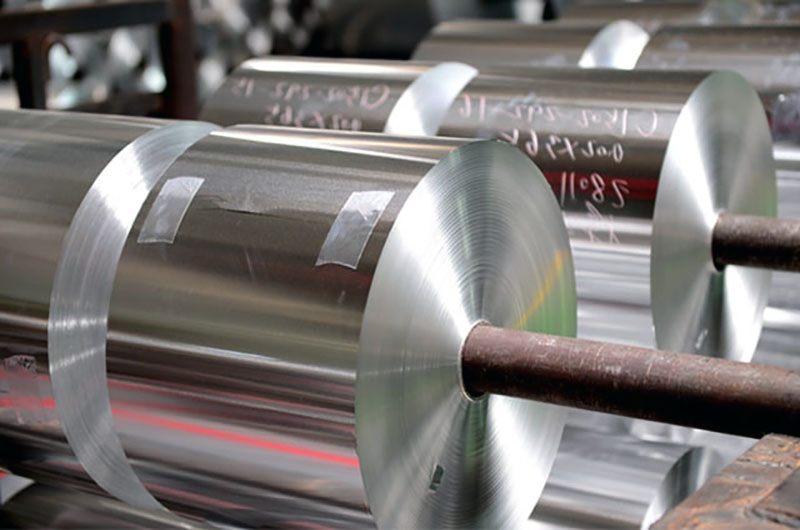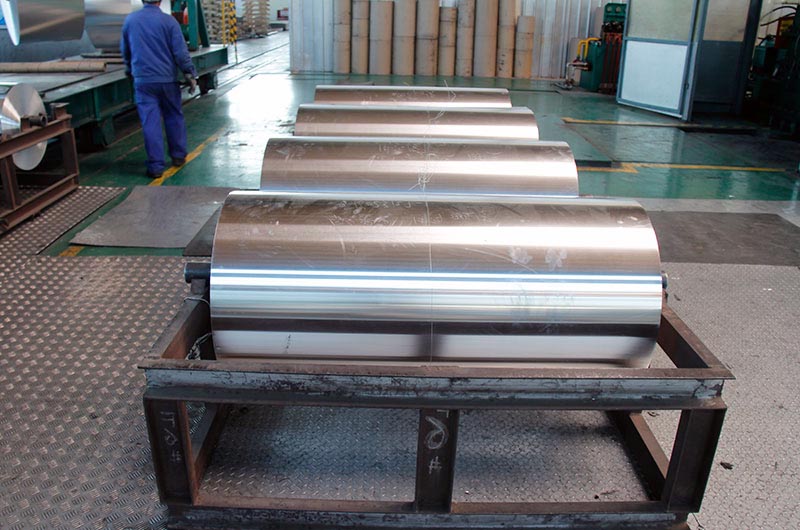- Properties of 5052 Aluminum Foil
- Technical Parameters Of 5052 Aluminum Foil
- 5052 Aluminum Foil Mechanical Properties
- Physical Properties of 5052 Aluminum Foil
- Common Thickness 5052 Aluminum Foil
- Applications of 5052 Aluminum Foil
- 5052 Aluminum Foil Quality Requirements
- Aluminum Foil 5052 Production Process
- Sustainability Aspects
- 5052 Aluminum Foil Packaging and Shipping
- FAQ Of 5052 Aluminum Foil
- People also Asks about 5052 Aluminum Foil
Aluminum, a versatile and widely used metal, plays a crucial role in various industries due to its lightweight, corrosion-resistant, and recyclable nature.
Among the numerous aluminum alloys available, 5052 aluminum alloy stands out, especially in the form of aluminum foil.
The alloying rate of 5052 is higher than that of 3003 aluminum but lower than that of 8011 alloys. The performance of 5052 aluminum alloy foil shows medium strength. Good formability. Good corrosion resistance. Good surface treatment effect.

Properties of 5052 Aluminum Foil
1. Corrosion Resistance
5052 aluminum foil is known for its exceptional corrosion resistance, making it suitable for applications in harsh environments, such as marine and chemical industries.
The alloy forms a protective oxide layer on its surface, preventing corrosion and ensuring durability.
2. Formability and Workability
One of the key features of 5052 aluminum foil is its excellent formability, allowing it to be easily shaped, bent, and stamped without cracking.
This property makes it a preferred choice for intricate and complex manufacturing processes.
3. Strength and Durability
5052 aluminum alloy exhibits good strength characteristics, providing structural integrity to the finished product.
The foil maintains its strength even at low temperatures, making it suitable for applications in extreme climates.
4. Weldability
The alloy is highly weldable, enabling the fabrication of seamless joints in various applications.
Welded 5052 aluminum foil structures retain their mechanical properties, contributing to the overall reliability of the product.
Technical Parameters Of 5052 Aluminum Foil
- Alloy: 5052
- Temper: O, H18, H22, H24, H26
- Thickness: 0.006 mm - 0.2 mm
- Width: 100 mm - 1600 mm
- Surface Treatment: Mill finish, coated
- Production Standards: ASTM B209, EN 573, EN 485
5052 Aluminum Foil Mechanical Properties
- Tensile Strength: 210 - 305 MPa
- Yield Strength: 83 - 228 MPa
- Elongation: 12 - 20%
- Hardness (Brinell): 47
Physical Properties of 5052 Aluminum Foil
- Density: 2.68 g/cm³
- Melting Point: 607 - 649°C
- Thermal Conductivity: 138 W/m·K
- Electrical Conductivity: 40% IACS
- Coefficient of Thermal Expansion: 23.8 x 10^-6 /°C

Common Thickness 5052 Aluminum Foil
The thickness of 5052 aluminum foil can vary depending on the specific requirements of different applications.
0.0059 inches (0.15 mm) and below:
Ultra-thin aluminum foil used in flexible packaging, such as food packaging, pharmaceutical packaging, and other similar applications.
0.0063 to 0.0079 inches (0.16 to 0.20 mm):
Commonly used for various packaging applications, including food packaging, beverage packaging, and pharmaceutical packaging.
0.0087 to 0.0118 inches (0.22 to 0.30 mm):
Medium thickness aluminum foil used in a range of applications, including insulation, automotive components, and some industrial uses.
0.0138 to 0.0197 inches (0.35 to 0.50 mm):
Thicker foil used in industrial applications, such as automotive components, heat exchangers, and some structural components.
0.0236 inches (0.60 mm) and above:
Heavy-duty aluminum foil used for more demanding industrial applications, such as aerospace components, marine applications, and structural elements.
Applications of 5052 Aluminum Foil
5052 Packaging Aluminum Foil
5052 aluminum foil is extensively used in the packaging industry for its ability to maintain the freshness and integrity of food products.
Its impermeability to light, gases, and moisture makes it an ideal choice for packaging perishable items.
5052 Aluminum Foil for Lunch Box Container
5052 aluminum foil, 3003 aluminium foil, as well as 8011 aluminum foil, are the typical raw material of lunch box. 5052 container foil used for lunch box has moderate strength, good deep drawability, high gloss, etc. It’s also cost-effective!
5052 Honeycomb Aluminum Foil
5052 honeycomb aluminum foil is generally used in construction, which uses multi-layer aluminum foil bonding, lamination, and then stretching into a regular honeycomb shape.
Due to its unique structure, it is not only the lightest among other materials of the same volume, but also has excellent rigidity and overall stability. It has sound insulation and thermal insulation properties.

Marine Applications
Due to its outstanding corrosion resistance, 5052 aluminum foil is widely utilized in the construction of marine components, such as boat hulls and structures.
It withstands the corrosive effects of saltwater, ensuring the longevity of marine vessels.
Aerospace Industry
The lightweight nature of 5052 aluminum foil, coupled with its strength and corrosion resistance, makes it a preferred material for aircraft components.
It is commonly employed in the construction of aircraft wings, fuselage panels, and other critical parts.
Electronics and Electrical Industry
The foil is used in the manufacturing of electronic enclosures and components due to its electrical conductivity and formability.
Its lightweight nature is advantageous in portable electronic devices.
5052 Aluminum Foil Quality Requirements
1. Flat Pattern
The flat pattern of the foil is crucial for applications where a smooth and uniform surface is required. This ensures ease of handling during manufacturing processes and contributes to the overall quality of the end product.
2. Surface Requirements
The surface of the 5052 aluminum foil must meet high standards, prohibiting any defects such as black spots, oil residues, scratches, small black wires, color variations, bright lines, roll marks, convex-concave points, and other imperfections. This ensures a visually appealing and functionally reliable material.
3. Thickness Accuracy
Strict adherence to specified thicknesses is essential to meet the requirements of different applications. Accurate thickness control is critical for achieving desired mechanical and performance properties in the final product.
4. Pinholes
The absolute absence of pinholes or holes in the 5052 aluminum foil is a vital quality requirement. Pinholes can compromise the material's integrity and may lead to issues such as reduced barrier properties in packaging applications.
5. Trimming Quality
Trimming quality is a significant aspect of the foil's appearance and functionality. The absence of burrs, cirriform (hair-like irregularities), enamel layer defects, scallops, flanges, or convex-concave points ensures a clean and consistent edge, which is essential in various manufacturing processes.
6. Packaging
Packaging plays a critical role in preserving the quality of the 5052 aluminum foil. Moisture protection is crucial to prevent degradation, and measures should be in place to avoid oxidation. Proper packaging ensures that the foil retains its properties during storage and transportation.
Adhering to these stringent quality requirements is essential for ensuring that the 5052 aluminum foil meets the high standards demanded by industries with precision applications.
Aluminum Foil 5052 Production Process
- Alloying: Aluminum ingots are alloyed with magnesium, resulting in the 5052 aluminum alloy with improved strength and corrosion resistance.
- Casting: The molten alloy is cast into large slabs or billets.
- Rolling: The cast material is hot or cold rolled into thin sheets of the desired thickness.
- Annealing: The foil may undergo annealing processes to enhance its formability and mechanical properties.
- Finishing: The foil is then trimmed to the specified width and subjected to surface treatments if required.
Sustainability Aspects
1. Recyclability
Aluminum, including 5052 alloy, is highly recyclable without loss of quality. Recycling aluminum requires only a fraction of the energy needed for primary production, contributing to energy conservation and reduced carbon emissions.
2. Resource Efficiency
The extraction of aluminum from bauxite, the primary ore, requires significant energy. However, the use of recycled aluminum, which is prevalent in the industry, reduces the demand for primary production and conserves natural resources.
3. Longevity and Durability
Products made from 5052 aluminum foil often have extended lifespans due to the alloy's corrosion resistance and durability. This longevity contributes to sustainable consumption patterns by reducing the frequency of replacements.
5052 aluminum foil is a remarkable material that embodies a harmonious blend of strength, formability, and corrosion resistance. Its applications in diverse industries, coupled with its sustainability aspects, make it a material of choice for manufacturers aiming for reliability and environmental responsibility.
As industries continue to evolve, the role of 5052 aluminum foil is likely to expand, contributing to a more sustainable and technologically advanced future.
5052 Aluminum Foil Packaging and Shipping
Packaging
5052 aluminum foil is carefully packaged to ensure its quality during transportation and storage. Common packaging methods include:
- Wooden pallets
- Plastic film wrapping
- Moisture-proof packaging
Shipping
The foil is shipped in compliance with international standards. Precautions are taken to prevent damage during transit, and shipping containers are equipped with measures to protect against moisture and oxidation.
FAQ Of 5052 Aluminum Foil
Q1: What are the key applications of 5052 aluminum foil?
5052 aluminum foil finds applications in the aerospace industry, packaging (especially for food and pharmaceuticals), marine components, and electronics due to its excellent combination of strength, formability, and corrosion resistance.
Q2: Can 5052 aluminum foil be welded?
Yes, 5052 aluminum foil is highly weldable. Welded joints retain the mechanical properties of the base material, making it suitable for various fabrication processes.
Q3: What is the significance of the 'O' temper in 5052 aluminum foil?
The 'O' temper indicates a fully annealed condition, providing the highest level of formability. It is suitable for applications where extreme forming is required.
People also Asks about 5052 Aluminum Foil
- What is 5052 aluminum sheet used for?
- Is 5052 aluminum food safe?
- What grade of aluminum is aluminum foil?
- Can 5052 aluminum be heat treated?
